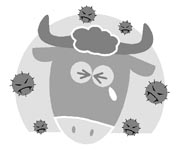What Korea needs now: More cowbell

According to “Samguk Sagi,” or “History of the Three Kingdoms,” King Jijeung of Silla recommended using cows to plow fields, and the agricultural use of cows began. In an agrarian society such as Korea’s, cows were the most valuable asset.
Cows were so valuable during the Joseon Dynasty that a cattle registry was maintained to prevent arbitrary butchering. A major document kept at town offices was a cattle registry with the shape of the horn and the color and pattern of the coat.
The most notable type of Hanwoo are yellow, but there are black and white varieties as well. Others have spots and look like tigers. These went nearly extinct when the Japanese colonial government only promoted the yellow variety. Today, some 400 spotted Hanwoo cows are being raised on Ulleung Island in the East Sea.
When farmers no longer used cows to work the land, they began to be used for meat. American cultural anthropologist Margaret Mead wrote that the French and English have 35 different cuts of beef, the Bodi tribe in Africa has 51 cuts, while the Koreans have a staggering 120 different cuts. Beef is usually sold in 39 different cuts today, with eight varieties of short ribs alone.
These days, there are many different brands of Hanwoo. Each farm proudly advertises the type of feed, the timing of castration and other techniques that make its meal special.
Now, the country’s cows are suffering from foot-and-mouth disease, which has spread to farms of six leading Hanwoo brands in Gangwon.
A cow named “Yellow” in the movie “Cow Bell” has now become a legend in the era of foot-and-mouth disease, when thousands of cows are being slaughtered as a preventative measure against the disease. Yellow lived for 40 years, when the average life span of a cow is 20 years.
Yellow’s owner, a man named Mr. Choi, donated 1 million won ($890) to aid foot-and-mouth disease prevention.
But I fear it will be a while before we hear the beautiful sound of cow bells in this country again.
*The writer is an editorial writer of the JoongAng Ilbo.
By Park Jong-kwon










with the Korea JoongAng Daily
To write comments, please log in to one of the accounts.
Standards Board Policy (0/250자)